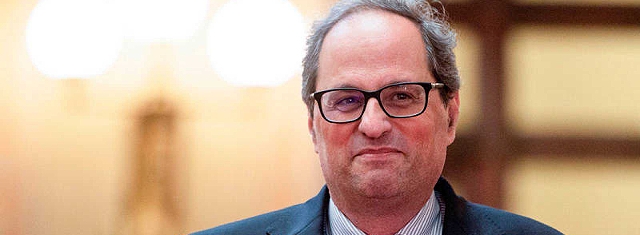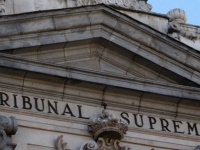Politics
Spanish Supreme Court disqualify the Catalan president
For disobedience

Quim Torra (Source: RTVE)
USPA NEWS -
Spanish Supreme Court unanimously agreed this Monday to disqualify the president of the regional government of Catalonia, Quim Torra, for 18 months, for disobedience to the courts and the Central Electoral Board, which during the legislative elections on April 2019, ordered the president to remove in the public buildings of Catalonia of banners in favor of independence. Order that the Catalan president disobeyed on several occasions.
The Chamber II of the Supreme Court has confirmed the sentence to the president of the regional government of Catalonia, Joaquim Torra, to 1 year and 6 months of special disqualification and a fine of 30,000 euros for a crime of disobedience committed by an authority or public official, considering that it repeatedly and stubbornly disobeyed the orders of the Central Electoral Board (JEC it's acronym in Spanish) to remove certain symbols from public buildings dependent on the Generalitat during the electoral process of the general elections called for April 28, 2019, as the Board considered that they violated neutrality required of public administrations in these processes.
The Supreme Court, in a ruling handed down unanimously, dismisses Torra's appeal and fully confirms the ruling of the Superior Court of Justice of Catalonia, of December 19, 2019. The ratified ruling condemned a 1 and a half year of special disqualification for both the exercise of elective public offices, whether at local, regional, state or European level, as well as for the performance of government functions, at local, regional and State levels.
In its judgment, the Supreme Court emphasizes that the scope of the appeal “is not the display of certain symbols or banners of a certain political option, but their use in electoral periods, disobeying the provisions of the Central Electoral Board, which, in the exercise of its functions, guarantees the transparency and objectivity of the electoral processes, prohibited their use, in violation of the principle of neutrality to which administrations in general must abide, contrary to express orders of that Electoral Board.“
It is not freedom of expression
In this sense, the Chamber emphasizes that the agreements of the Central Electoral Board did not violate Torra's rights to ideological freedom and freedom of expression. The High Court insists that “the purpose of the process is not to analyze the appellant's conviction from the perspective of freedom of expression, since as a citizen he is free to carry out demonstrations or acts that reflect his political identity. The object is the disobedience of the repeated orders of a constitutional body whose function is to guarantee the transparency and cleanliness of the electoral processes that requires the neutrality of the powers and public administrations.“
It adds that "the Administration's demand for neutrality becomes more acute in electoral periods," and cites its jurisprudence to emphasize that "free suffrage" "means proclaiming as an essential design of true democracy the establishment of an electoral system that guarantees an institutional framework. of neutrality in which the citizen can with absolute freedom, without interference from any public power, decide the terms and scope of his political participation.“
To rule out the violation of the right to the presumption of innocence, the Supreme Court assumes that Torra “at all times, before, during and after the oral trial, has not denied the display of banners and other symbols in public buildings dependent on the Generalitat Palace ““ headquarter of the regional goverment of Catalonia -, especially on the facade of the Palace, and his refusal to comply with the orders of the Central Electoral Board,“ although the appellant alleged that they were illegal orders and that they violated his freedom of expression.
Willful and stubborn resistance
In conclusion, the Supreme Court confirms, in view of everything analyzed, "the forceful, repeated, stubborn and obstinate resistance of the accused to comply with a mandate invested with authority and issued in accordance with the law." The Chamber considers that in addition to disregarding the mandate of the Central Electoral Board, the appellant had a conscious will and an unequivocal mental disposition of contravention. The sentence details that the enforceable fraud does not consist in wanting to commit a crime of disobedience, but in wanting to violate the order of a higher authority.
The court recalls that the appellant is president of the regional government of Catalonia and also a writer and lawyer, with above-average legal training and knowledge, which together with the various reports sent by the government's own Legal Services, on previous dates, on the exhibition of symbols in the headquarters of the autonomous administration, make it possible to conclude, according to the Chamber, “that the appellant today had sufficient elements on the obligation to comply with the mandates of the JEC, not only for their own content but also for the terms of the reports of the Legal Services that clear up any doubts about the full awareness that the accused had about the effects associated with the JEC agreements, without being able to speak of any error."
Likewise, the Chamber endorses the special disqualification for the exercise of elective public positions and adds that the appellant has been sentenced in his capacity as a public authority - who held his position of a political nature - for openly refusing to comply with an order emanated from higher authority, “thus imposing its will against the mandate of the JEC agreements of Mars 11 and 18, 2019. In this sense, the court considers that the disqualification penalty - which is established as the main penalty for the aforementioned crime - should cover any area in which the crime is committed.
Liability for this article lies with the author, who also holds the copyright. Editorial content from USPA may be quoted on other websites as long as the quote comprises no more than 5% of the entire text, is marked as such and the source is named (via hyperlink).






